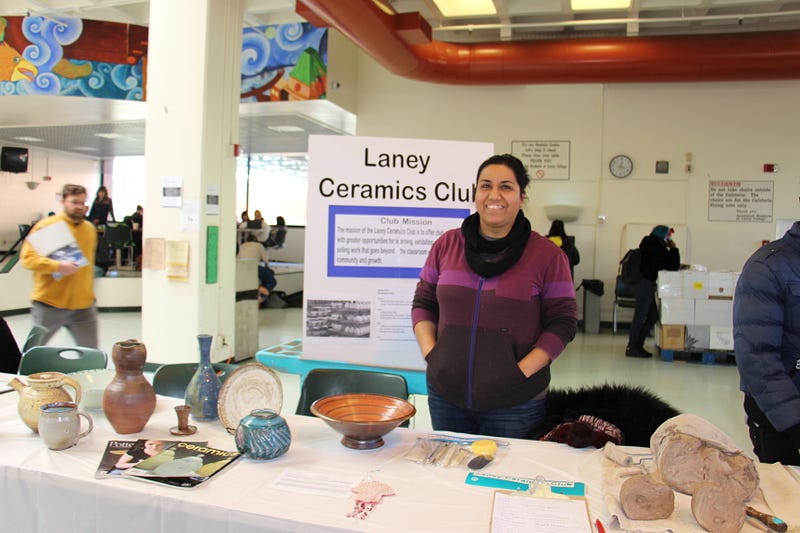by Eva Hannan/Co-editor

Have you heard? Clay is cool again!
One of the most ancient methods of human craftsmanship, clay has been used as a material for building and kitchenware since the dawn of human civilization. The earliest example of human-made pottery dates from 14,000 B.C. and was discovered in Honshu, Japan.
The special thing about this dirt is that it can be shaped when wet, keeps that shape when dry and, if put in a very hot oven (called a kiln), it will become brittle and waterproof.
Since the 1950’s and 60’s, working in clay has gone through some important changes and is now considered to be both a craft and a fine-art form.
Spring Montes, founder and president of the Laney Ceramics Club, could be considered a part of that trend. Her large and kinetic installations of paper-thin porcelain components create movement and sound from a built-in wind source, and push the boundaries of clay’s traditional uses.
Unfortunately, the world of fine art is hard to enter, and often requires expensive overhead that poorer artists and casual hobbyists can ill-afford.
Montes began the Ceramics Club to help her fellow potters document their work and learn how to exhibit their pieces.
“If you’re trying to get into publications or juried shows, or trying to get a scholarship or residency, they need quality images,” she said, in order to be considered for what is often a highly competitive showcase.
Learning how to work in clay is one part of the larger process, but the other aspects of breaking into the art world are typically under-emphasized in ceramics courses.
Just 20 years ago, clay was “definitely the ugly cousin of art,” Montes said, and therefore not a true “artistic” outlet. Even now, documenting clay work can be more challenging than other art forms.
“It’s not easy to light ceramics. They can be shiny, or irregular,” Montes said. For that reason, a professional photography studio is invaluable but often inaccessible to those who work in clay.
Although the art world’s view of ceramics has been changing, many of the aspects that make working in clay unique remain in place. The biggest difference is in the studio atmosphere that accompanies the work.
“Clay in general is very community-related,” Montes said. “A painter can go anywhere and have their little pocket full of stuff and do their thing, but we all have to share. There isn’t a kiln that you can just take anywhere in your pocket.”
Additionally, clay is heavy and fragile, so it is not advisable to transport during construction. This forces artists to be in the studio, often with the same people, for long hours. Camaraderie and friendship can result, and potters often get together outside of the studio to share the other aspects of their lives, such as a meal.
“A lot of it has to do with the fact that you’re making utilitarian objects, and then you want to use your objects,” Montes said. Having a potluck or a barbeque is a way to get together outside of the studio and show off the usefulness of what has been made.
Thanks to Montes, Laney ceramics students will also have the chance to show off their work at the largest ceramics event on the west coast.
Over 30 colleges and universities from California and Oregon will attend the 32nd annual California Conference for the Advancement of Ceramic Arts. The conference takes place at the John Natsoulas Gallery in Davis May 3–5.
Thanks to the Ceramic Club, about 10 artists from Laney’s ceramic program will also be able to display their work.
The artists will also be exposed to a vast variety of methods and aesthetics, and will see how the strengths of teachers are passed down and interpreted by their students in different ways.
“The thing about working in clay, it’s all about what you get exposed to,” Montes said. “That leads you on your journey, and the less you’re exposed to the more limited your journey.”
Safe travels, Ceramics Club.
Box: The Laney Ceramics Club meets every Saturday 2–3 p.m. in the Art Center Ceramics Studio. The club is open to any student working with fired clay as their material. Taking a ceramics course is not required to join the club. Contact [email protected]

























